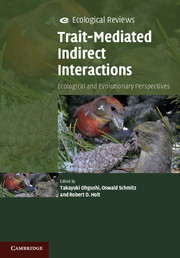Book contents
- Frontmatter
- Contents
- Contributors
- Foreword
- Preface
- Chapter One Introduction
- Part I Community
- Part II Coevolution
- Part III Ecosystem
- Chapter Sixteen Perspective
- Chapter Seventeen Species functional traits, trophic control and the ecosystem consequences of adaptive foraging in the middle of food chains
- Chapter Eighteen Effects of herbivores on terrestrial ecosystem processes
- Chapter Nineteen Functional and heritable consequences of plant genotype on community composition and ecosystem processes
- Chapter Twenty Microbial mutualists and biodiversity in ecosystems
- Chapter Twenty-One Integrating trait-mediated effects and non-trophic interactions in the study of biodiversity and ecosystem functioning
- Part IV Applied Ecology
- Index
- Plate Section
- References
Chapter Twenty-One - Integrating trait-mediated effects and non-trophic interactions in the study of biodiversity and ecosystem functioning
Published online by Cambridge University Press: 05 February 2013
- Frontmatter
- Contents
- Contributors
- Foreword
- Preface
- Chapter One Introduction
- Part I Community
- Part II Coevolution
- Part III Ecosystem
- Chapter Sixteen Perspective
- Chapter Seventeen Species functional traits, trophic control and the ecosystem consequences of adaptive foraging in the middle of food chains
- Chapter Eighteen Effects of herbivores on terrestrial ecosystem processes
- Chapter Nineteen Functional and heritable consequences of plant genotype on community composition and ecosystem processes
- Chapter Twenty Microbial mutualists and biodiversity in ecosystems
- Chapter Twenty-One Integrating trait-mediated effects and non-trophic interactions in the study of biodiversity and ecosystem functioning
- Part IV Applied Ecology
- Index
- Plate Section
- References
Summary
The need to consider trait-mediated effects and non-trophic interactions in the study of biodiversity and ecosystem functioning
The relationship between biodiversity and ecosystem functioning has emerged as a central issue in ecology during the past two decades because of increasing concerns about the potential ecological and societal consequences of current biodiversity loss (Loreau et al. 2001; Naeem et al. 2009; Loreau 2010). Biological invasions are one of the main drivers of this biodiversity loss as human activities contribute to accelerate introductions of exotic species in many of the world’s ecosystems, with considerable economic impacts (Williamson 1996; Mooney and Hobbs 2000). Although the effects of biodiversity loss on ecosystem functioning have now been studied in a wide range of organisms and ecosystems (Hooper et al. 2005; Balvanera et al. 2006; Cardinale et al. 2006; Naeem et al. 2009), most experimental and theoretical studies have considered either competitive communities at a single trophic level or relatively simple food webs (Duffy et al. 2007). The only direct species interactions considered in these studies are trophic interactions, and the only indirect species interactions considered are density-mediated interactions (for instance, exploitation competition). Similarly, the impacts of biological invasions on native ecosystems and the relationship between biodiversity and invasion resistance have been mainly studied in experimental plant communities (e.g., Kennedy et al. 2002) and models that consider a single type of species interactions, either competition (e.g., Case 1990; Byers and Noonburg 2003) or trophic interactions (e.g., Law and Morton 1996).
- Type
- Chapter
- Information
- Trait-Mediated Indirect InteractionsEcological and Evolutionary Perspectives, pp. 414 - 432Publisher: Cambridge University PressPrint publication year: 2012
References
- 3
- Cited by

